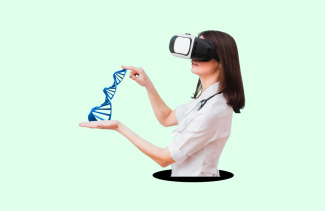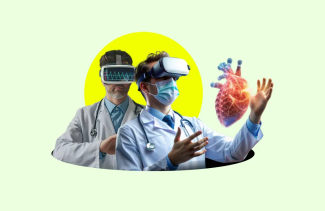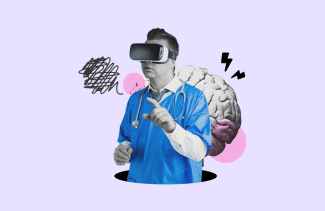
The market of augmented and virtual reality in healthcare amounted to a forecast of 18.8 billion U.S. dollars in 2020. Healthcare, which was always dependent on cutting-edge solutions, seems like a natural fit and one of the most promising areas for AR and VR.

Various healthcare apps have been developed today that offer much better and faster services, thanks to the advancements made by healthcare app developers. When any technology gets more advanced, its cost comes down, making it accessible to a wider audience. The same is happening with implementing Virtual Reality and Augmented Reality in healthcare, and more medical specialists are eager to check the benefits they offer. Patients also respond positively to using AR/VR in healthcare services. The changes that technology can bring may be equally transformational for the healthcare sector employees and patients.
Use Cases of Augmented Reality in Healthcare
The crucial requirement for using Augmented Reality in healthcare is that the software should be light-weight and easy to use during any medical procedures, from examination to surgery. AR fits perfectly since it can be used even through smartphones, and soon could be featuring in built-in glasses or even contact lenses.
Another advantage of AR is that it doesn’t create a completely detached virtual world as VR does. AR allows keeping in touch with reality, and all the information appears before your eyes as quickly as possible.
So, what opportunities are associated with AR for healthcare professionals and patients? Here are a few examples.
1. Medical Studies with AR-
AR enables patients, medical students, and even kids to learn about the human body interactively. Virtual-Tee is one such example. It is a t-shirt, but if used with the special app that projects a very realistic hologram of human organs, it becomes a powerful learning instrument. Users can explore organs through colorful holograms, animations, and 3D images.

2. The Use of AR in Surgeries-
AR healthcare applications can help during surgeries. MRT and CT data uploaded into AR glasses or headset allows overlaying a patient’s anatomy details onto his or her body. The ability to ‘see-through’ the outer tissue would help in making injections and incisions more accurate. AR can also be used to display various information, from pulse and inner pressure to overall medical records.
3. AR to Find the Right Veins-
AR may assist in finding the veins. It can be used in a scanner that projects over the skin and shows precisely where the patient’s veins are. This makes life easier both for patients and nurses. This approach may also be applied to diagnose and examine varicose and reticular veins.

4. Pharma Companies and AR-
Pharma companies may use AR as well. Instead of printing long drug descriptions, AR-powered apps may show how they work. All of that happens in 3D. Besides patients, such a solution may be useful for lab workers to monitor their experiments.

5. The Use of AR for Fitness-
AR can help motivate people to exercise. Gamified experiences can help people keep fit in a fun way. For example, a game called Zombies, Run is somehow similar to the acclaimed Pokémon Go. However, instead of chasing pokemon, the player needs to run away from virtual zombies - while running in the real world.

Use Cases of VR in Healthcare
Employing VR throughout various branches of healthcare promotes higher quality and efficiency of services, from medical examination to therapy, from surgery to patient care.
Let’s look at some ways to put the use of Virtual Reality in healthcare purposes.
1. The Use of VR in Medical Training
Virtual reality in the medical field has brought a revolution to the processes of medical training. With Medicine being a complex subject infused with a lot of pathways, visualization through VR is a game-changer because people memorize visual information better, especially if it is interactive.
For example, medical students can closely watch interactive videos of how surgeries are performed, with no need to jump over the senior surgeon’s shoulders. They can also rehearse complex surgeries beforehand and as many times as they want.
2. Studying Cancer More Thoroughly
With a virtual 3D model of a tumor (or any other troublesome cells, virus or bacteria), it becomes possible to study them up close. No detail or angle will be missed.
Researchers initially tried with one cubic millimeter of cancer tissue biopsy, and such a tiny bit contains around 100,000 cells to study. That piece was then rebuilt for VR so it can be studied multiple times. A more profound study of cancer will hopefully lead to discovering new ways to treat it.

3. Rehabilitation After Brain Injury
Creating virtual day-to-day tasks helps patients to recover cognitive functions with confidence. They ‘live’ through some simple tasks, such as a game or a shopping routine, in virtual environments. Meantime, doctors can monitor their activities and notice when a patient suffers while making a decision or an unnoticed memory loss reveals itself. This makes it easier for medical specialists to prescribe the proper treatment.
4. Assisting Patients who Suffer from PTSD
Special virtual experiences expose patients to PTSD triggers bit by bit. Unlike real-world triggers, virtual situations are completely manageable, so patients can slowly learn to manage them in real life too.
5. Aiding Children with Autism
VR helps train social skills. Patients are slowly exposed to completely manageable social situations, such as getting a haircut. In the long run, it helps in similar scenarios in real life.
6. Pain management
VR headsets may be used not only to distract children and other patients during any unpleasant medical procedures but also to help patients with chronic pain, and even depression. These headsets make them feel better for a while, reducing their consumption of prescription drugs.
7. Early Identification and Treatment of Brain Disorders
Some VR-based tests and games allow diagnosing the early stages of Alzheimer’s and schizophrenia. Thus, treatment can be initiated earlier and there are more chances for halting the diseases. Moreover, this diagnostic method proved to be much cheaper than traditional neuroimaging.
To reduce the level of depression, AR and VR scenarios are created in which a patient is, for example, transported to a beautiful location, participates in a fun activity, or has to soothe and express compassion to an anxious virtual child. Such therapy is both safe and effective.
8. Medical Device Makers Benefit from VR’s Abilities too
Instead of personally giving instructions or demonstrations to every specialist that might be interested, medical device makers use VR to present their products.
What Is the Future of AR and VR in Healthcare?
The future impact of VR and AR in healthcare applications is expected to be resounding. While both are expected to transform the industry, they can provide realizable solutions to a variety of day-to-day cases and a lot of educational opportunities, such as a better understanding of human anatomy and various medical procedures.

Virtual environments allow medical and interprofessional training to be conducted more easily. They empower students and doctors to apply knowledge and practice skills until they are fully mastered. AR/VR-enabled devices have proved to be affordable and accessible tools for the day-to-day tasks of medical professionals. The technologies are even used to diagnose and treat some illnesses and conditions. While there are multiple healthcare apps for doorstep assistance, the integration of AR/VR in the industry is transforming the healthcare system.
When headsets can adequately recognize images and artificial intelligence-powered analysis develops sufficiently, AR/VR will become an incredibly powerful tool. We are not witnessing the AR/VR healthcare application boom yet; the technologies may have a long road ahead to become fully integrated into the industry.
However, their increasing accessibility and quality along with the significant advantages for specialists and patients let us predict a bright future for VR and AR in healthcare.
Frequently Asked Questions
-
How is Augmented Reality used in healthcare?
-
How is Virtual Reality used in healthcare?





